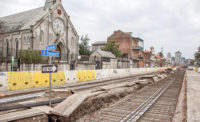The Huey P. Long Bridge in New Orleans officially reopened on June 16 after a seven-year $1.2-billion expansion project. It was recently awarded the Alliant Build American Grand Award and named one of the most significant construction projects of 2012 by the Associated General Contractors of America.

The project increased the driving surface from 18 feet to 43 feet with three eleven-foot lanes in each direction. MTI, a joint venture of Massman Construction Co., Kansas City, Mo., Traylor Bros., Evansville, Ind., and IHI Corp, Tokyo, Japan, was recognized for using a ninnovative method of lifting trusses that allowed the bridge to be widened with minimal impacts to vehicle, train and maritime traffic.
Massman Project Engineer Steve Hayes says it was a unique challenge to perform the construction within minimal bridge and waterway closures. The contractors worked with the U.S. Coast Guard to maintain strict schedules with mariners in what has historically been one of the most heavily trafficked waterways in the country.
"Everything had to be done with minimal impact. Interruptions to vehicular traffic had to be limited and interruptions to railroad or maritime had to be negotiated," says Hayes. "We had to work with [all three] everyday."
MTI was responsible for the main bridge-widening portion of the project. In order to accomplish this, they constructed two of the massive trusses on barges then lifted them into place using four strand jacks. Hayes says each span was roughly 530 feet long and weighed 2,650 tons.
Road closures were often limited to late nights and early weekend mornings. The contractor was allowed to shut down the river for only 48 hours for each one and used a well-choreographed sequence. Once the spans were at the final elevation, they were pushed inwards 16 feet and placed on the piers. The two spans closest to each shore were built with traditional stick construction.
Hayes says the technique allowed them to eliminate the need for false work in the middle of the river and to complete the two central spans with minimal impact to maritime traffic.
"We had only three weekends during the entire project where we were allowed to close down the entire river. It worked well," he says.
Construction had started on April 2006 and consisted of four phases. Phases I and II included main support widening and railroad modifications. Phase IV included new approach construction and Phase III, the biggest element, included the main bridge widening.






Post a comment to this article
Report Abusive Comment